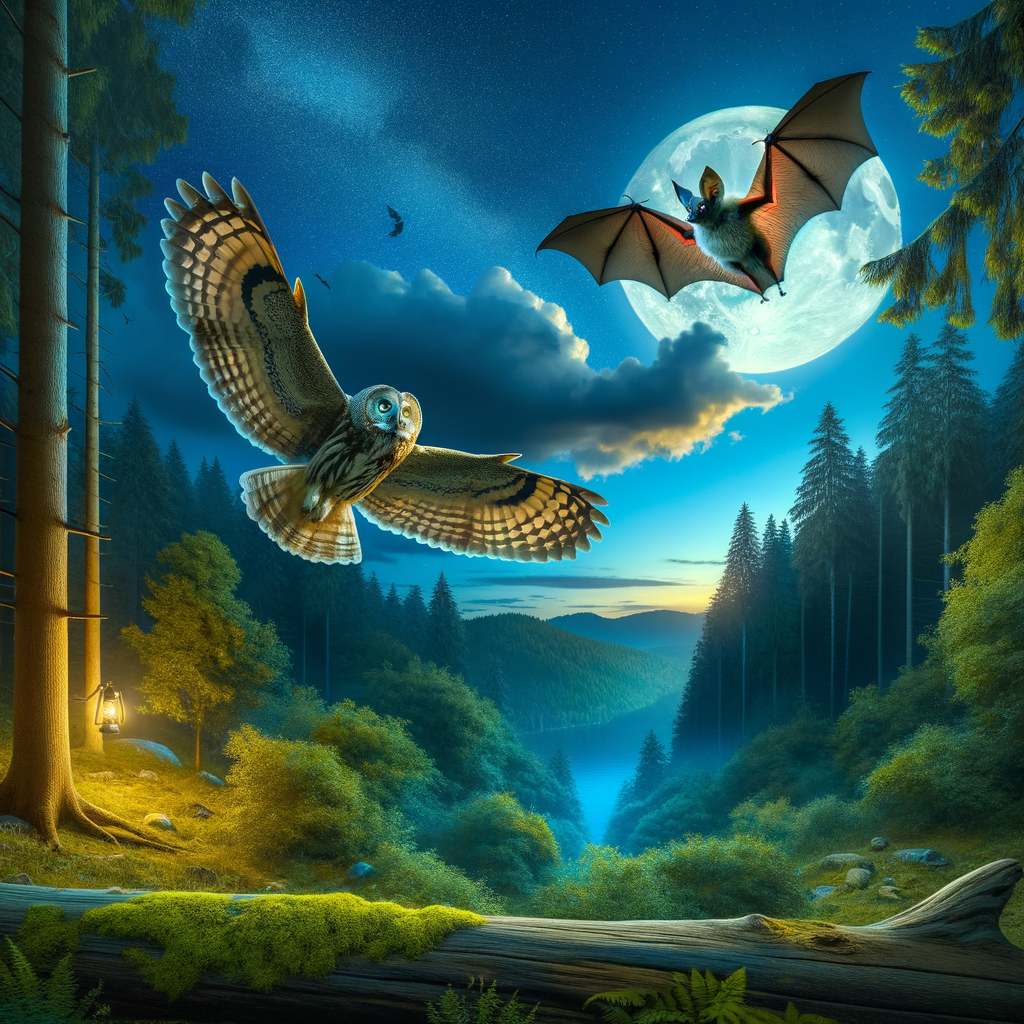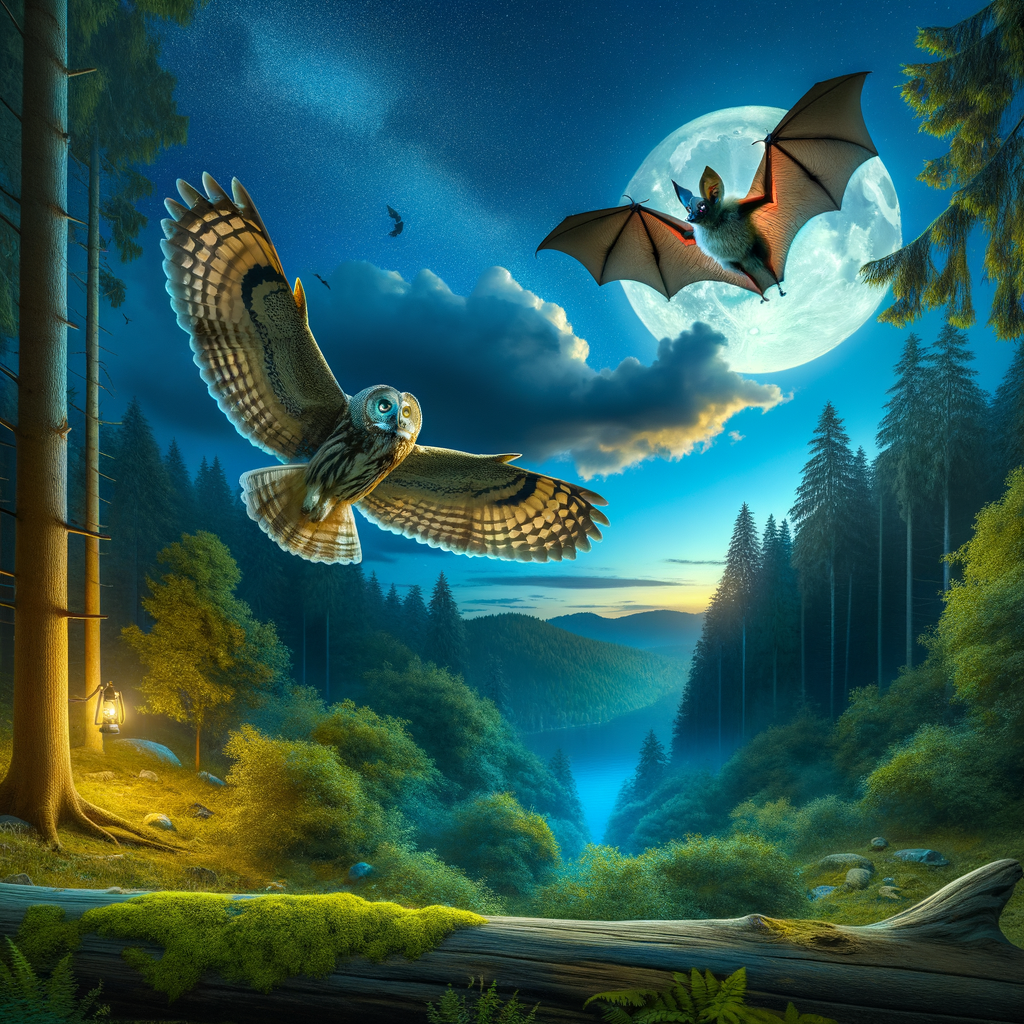
Introduction to Owls and Bats
- Nocturnal animals: Nocturnal animals are creatures that are active during the night and rest during the day. This behavior helps them avoid predators and hunt more effectively. Examples include owls and bats.
- Overview of owls and bats: Owls and bats are fascinating nocturnal animals. Owls are birds with large eyes and sharp talons, while bats are mammals with wings. Both play important roles in their ecosystems.
Owls and Bats Interaction
Overview of Owls and Bats Coexistence
- How owls and bats share the same habitat:Both like forests, caves, and old buildings. They need places to hide and sleep during the day. Owls use trees and barns, while bats hang upside down in caves and attics.
- Examples of owls and bats cohabitation:In many places, owls and bats can be found living close to each other. For example, in North America, the Barn Owl and the Little Brown Bat both live in barns and old buildings. They do not bother each other much.
Another example is in Europe, where the Tawny Owl and the Common Pipistrelle Bat share forest habitats. They both hunt at night but for different prey, so they do not compete for food.
Predator-Prey Dynamics between Owls and Bats
-
How Owls Prey on Bats
They use their sharp talons and beaks to catch bats. Owls have excellent night vision, which helps them see bats in the dark. They also have silent flight, allowing them to sneak up on bats without being heard.
For example, the Barn Owl is known to hunt bats by waiting near cave entrances where bats live. When the bats come out at night, the owl swoops down and catches them.
According to Wikipedia, owls have special feathers that make their flight almost noiseless, giving them an advantage over their prey.
-
Defensive Mechanisms of Bats Against Owls
One way is by flying in zigzag patterns, making it harder for owls to catch them. Bats also use their echolocation to detect owls nearby. Echolocation helps bats “see” in the dark by using sound waves.
Some bats, like the Mexican Free-tailed Bat, fly in large groups. This makes it harder for an owl to single out one bat to catch. The group flying also confuses the owl.
According to Wikipedia, bats have a high-pitched call that helps them navigate and avoid predators.
Owls and Bats Ecological Impact
Owls and Bats Habitat Overlap
- How habitat overlap affects their behavior:Owls and bats often share the same habitats, such as forests and caves. This overlap can affect their behavior in several ways. For example, both animals are nocturnal, meaning they are active at night. This can lead to changes in their hunting patterns to avoid each other.
- Impact of habitat overlap on their food competition:When owls and bats live in the same area, they might compete for the same food. Owls mainly eat small mammals, while bats eat insects. However, in times of food scarcity, their diets might overlap, leading to competition. This can affect their populations and health.
Owls and Bats Ecosystem Roles
-
Role of Owls in the Ecosystem
They are known as apex predators, meaning they are at the top of the food chain. Owls help control the population of small mammals, such as mice and rats. This keeps the ecosystem healthy and prevents overpopulation of these species.
For example, a single barn owl can eat up to 1,000 mice in a year. By doing this, owls help farmers by reducing the number of pests that can damage crops. This natural pest control is crucial for agriculture.
Owls also contribute to the biodiversity of their habitats. By preying on various animals, they help maintain a balance among different species. This ensures that no single species dominates the ecosystem.
-
Role of Bats in the Ecosystem
They are known as pollinators and seed dispersers. Many plants rely on bats to pollinate their flowers. This includes important crops like bananas, mangoes, and guavas.
In addition to pollination, bats help control insect populations. A single bat can eat thousands of insects in one night. This includes mosquitoes and other pests that can spread diseases. By controlling insect populations, bats help protect human health and agriculture.
Bats also play a role in seed dispersal. They eat fruits and then spread the seeds through their droppings. This helps new plants grow and contributes to forest regeneration.
| Animal | Main Role | Impact |
|---|---|---|
| Owls | Predator | Control small mammal populations, support agriculture |
| Bats | Pollinator and Insect Control | Pollinate plants, control insect populations, support forest regeneration |
Behavior Study of Owls and Bats
Behaviors of Owls
- How owls huntThey have excellent night vision, which helps them see in the dark. Their silent flight allows them to sneak up on their prey. Owls use their sharp talons to catch animals like mice and small birds.
For example, the Barn Owl can hear a mouse moving in the grass from over 30 feet away. This amazing hearing helps them find food even in complete darkness.
- Communication methods of owlsThey hoot, screech, and whistle to talk to each other. Each type of owl has its own unique calls. These sounds can mean different things, like marking territory or calling for a mate.
For instance, the Great Horned Owl is known for its deep hooting sound. This call can be heard from miles away and is often used to warn other owls to stay away from their territory.
Behaviors of Bats
-
How Bats Use Echolocation
Bats have a special way of finding their way in the dark. This is called echolocation. They make high-pitched sounds that humans can’t hear. These sounds bounce off objects and come back to the bat as echoes. By listening to these echoes, bats can tell where things are.
For example, a bat can find a tiny insect flying in the night. This helps them hunt for food. Some bats can even tell the size and shape of an object just by listening to the echoes. This is very important because bats are mostly active at night.
According to Wikipedia, there are over 1,400 species of bats, and most of them use echolocation. This makes them very special among animals.
-
Migration Patterns of Bats
Some bats travel long distances when the seasons change. This is called migration. They move to warmer places when it gets cold. This helps them find food and stay safe.
For instance, the Hoary Bat travels from Canada to Mexico during the winter. This is a journey of over 1,000 miles! Not all bats migrate, but those that do often travel in large groups.
Scientists study these patterns to understand more about bat behavior. They use special tags to track where bats go. This helps us learn how to protect them.
| Behavior | Description | Example |
|---|---|---|
| Echolocation | Using sound waves to locate objects | Finding insects in the dark |
| Migration | Traveling to warmer places | Hoary Bat moving from Canada to Mexico |
Owls and Bats Conservation
Threats to Owls and Bats
Owls and bats face many threats in the wild. Understanding these threats is key to their conservation.
- Impact of habitat destruction on owls and bats:When forests are cut down or caves are disturbed, these animals lose their homes. For example, the Spotted Owl is endangered due to logging in its habitat. Similarly, bats lose roosting sites when old trees are removed.
- Effects of climate change on owls and bats:Changes in temperature and weather patterns can affect food availability. For instance, warmer winters can reduce the insect population, which many bats rely on for food. Owls may find it harder to hunt if snow patterns change.
Conservation Efforts for Owls and Bats
-
Case Studies of Successful Conservation Efforts
Many projects have helped protect owls and bats. One example is the Bat Conservation International project. They worked to save the Bracken Cave in Texas. This cave is home to millions of bats. By protecting the cave, they helped the bat population grow.
Another success story is the Barn Owl Trust in the UK. They built nest boxes for barn owls. This gave the owls safe places to live and raise their young. As a result, the number of barn owls increased.
Project Location Outcome Bat Conservation International Bracken Cave, Texas Increased bat population Barn Owl Trust UK More barn owls -
How to Contribute to Owls and Bats Conservation
You can help owls and bats in many ways. Here are some ideas:
- Build a Bat House: Bats need safe places to live. You can build a bat house in your yard.
- Plant Native Trees: Owls and bats need trees for shelter. Planting native trees can help them find homes.
- Reduce Pesticide Use: Pesticides can harm owls and bats. Use fewer chemicals in your garden.
- Support Conservation Groups: Donate to groups that protect owls and bats. Your support can make a big difference.
By taking these steps, you can help protect these important animals. Every action counts!
Conclusion
- Summary of Owls and Bats Interaction and Coexistence: Owls and bats are fascinating creatures that often share the same habitats. They both hunt at night and have unique ways of finding food. While they may compete for some of the same resources, they also help balance the ecosystem by controlling insect and rodent populations.
- Importance of Owls and Bats in the Ecosystem: Both owls and bats play crucial roles in the environment. Owls help keep the number of small mammals in check, while bats are excellent at controlling insect populations. This balance helps maintain healthy forests and agricultural areas. Without them, we could see an increase in pests and a decrease in crop yields.
- Need for Continued Conservation Efforts: It’s important to protect both owls and bats. Many species are threatened by habitat loss, pollution, and climate change. Conservation efforts, like creating protected areas and reducing pesticide use, are vital. By supporting these efforts, we can help ensure that owls and bats continue to thrive and support our ecosystems.






